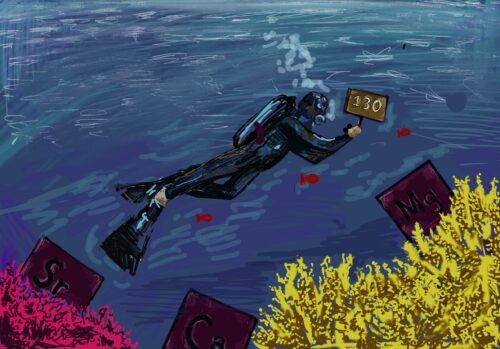Art Courtesy of Anna Olszowka
Look back on the beaches you’ve been to in the past decade. The serene sand, the soothing warmth of the sun, and most importantly, the refreshing splashes of the ocean waves. That same seawater may have contributed to a recent study that has overturned years of research. For over a century, scientists believed that charged particles, called ions, in seawater remained in relatively similar ratios across the ocean. However, a group of researchers have debunked this assumption, leading to concerns about the accuracy of past seawater studies that depended on it.
Mario Lebrato, a station manager and chief scientist at the Bazaruto Center for Scientific Studies in Mozambique, led the team that challenged this assumption about seawater ion proportions. Interestingly, the original intent of their study wasn’t to test this assumption. “Originally, we were trying to understand how plankton grew in different seawater conditions,” Lebrato said. His research team organized seawater samples from different parts of the world to analyze plankton growth. After measuring the composition of a few samples, Lebrato noticed significant differences in ion proportions between seawater from different sources. “This really triggered the project,” he said.
“It all started with the question of: why are these waters so different in terms of oceanic versus coastal?” Lebrato said. To further their investigation, his team organized partnerships with international universities, governments, and environmental agencies over seven years. They knew it would be hard to collect seawater samples worldwide without outside assistance or substantial funding. “It’s almost impossible for anybody to organize over a hundred research cruises,” Lebrato said. These partnerships ranged from organizations like the United States National Oceanic and Atmospheric Administration (NOAA) and Environment Canada, to small research cruises and individual scientists. Lebrato even received help from organizations that ventured into the Arctic Circle to retrieve seawater samples.
At the end of their seven-year project, Lebrato’s team concluded that the original assumption about ion proportions in seawater was incorrect. According to Lebrato’s research, there were significant deviations in major seawater ion ratios between samples, specifically in the open ocean. “Everybody knew it was expected to find deviations from the coast, deviations near the rivers, and deviations in the poles near the ice. But nobody was expecting significant deviations on the open ocean,” Lebrato said.
Upon discovering this flaw in this then-long-standing assumption on seawater ion ratios, Lebrato was initially worried about the international reaction to his team’s research. “I was pre-stressed because I was like, okay, maybe we’re doing something wrong,” Lebrato said. In the final stages of the research project, Lebrato’s team rechecked all of the data with the owners of the labs, ensuring the results were consistent. They remeasured open ocean samples up to five times to validate their results. After the researchers published the project, the international science community accepted the discovery. Lebrato was especially pleased with these results.
However, Lebrato’s group of researchers could not pinpoint all of the exact causes for these deviations in ion ratios. It’s possible that ocean and earth processes—such as weathering, evaporation, particle movement from ocean waves, and ion production from sea animals—contribute to these variances in the ion ratios of seawater. However, it is difficult to isolate the exact reasoning without further work. “The research basically opened a Pandora’s box for people to start revising the topic and doing experiments on it,” Lebrato said. After their paper was published, a wave of research proposals formed, with some looking to explore the cause of these varying ion ratios. Other research proposals looked to reevaluate the accuracy of past papers that relied on the now-overturned assumption.
It’s important to keep in mind that overturning assumptions is necessary in scientific research and isn’t a way to target other researchers. “We’re not pointing fingers at anybody,” Lebrato said. Instead, by debunking this assumption, new research opportunities have arisen to further investigate ocean chemistry. Revising and experimenting with these assumptions is a natural part of the research process and plays a crucial role in maintaining accuracy in the vast expanses of scientific literature.

